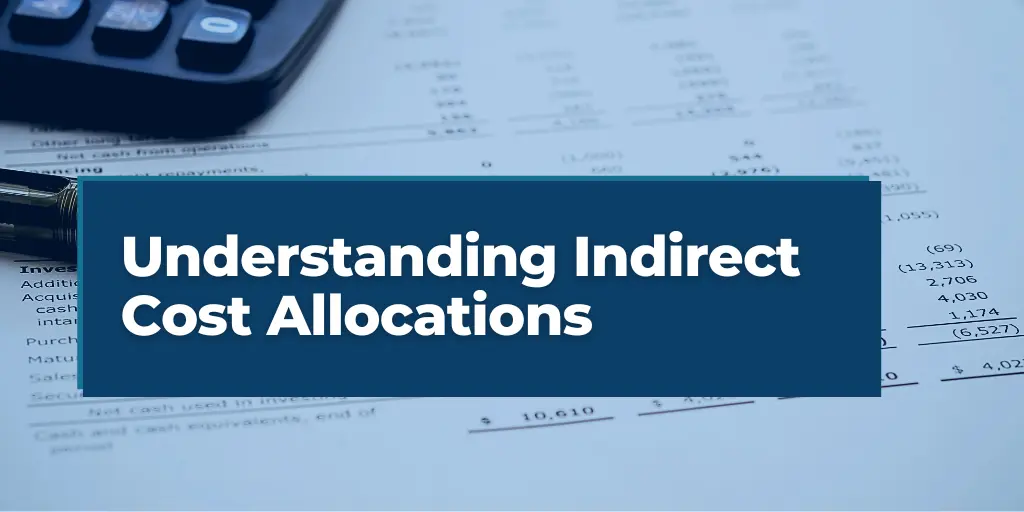In the world of nonprofit organizations, financial transparency is a critical factor in maintaining trust and building strong relationships with donors. One effective way that can enhance financial transparency is the Indirect Cost Allocation Table. This powerful tool allows organizations to effectively allocate their indirect costs and provide a clear breakdown of how these costs are distributed across different departments or programs.
However, creating an effective Indirect Cost Allocation Table can be a complex process. It requires careful consideration of cost drivers, allocation methods, and the specific needs of the organization. In this article, we will explore key strategies and best practices to help you create an Indirect Cost Allocation Table that boosts financial transparency and empowers your organization.
What is an Indirect Cost Allocation Table?
An indirect cost allocation table is a financial tool that outlines indirect costs incurred by an organization. Indirect costs are expenses that are not directly tied to a specific department or program but are necessary for the overall operation of the organization. These costs include rent, utilities, office supplies, administrative staff salaries, etc.
The allocation table breaks down these indirect costs and assigns them to different departments or programs based on predetermined allocation methods. This allows organizations to track and distribute indirect costs more accurately, leading to better cost management and resource allocation.
The importance of financial transparency in organizations
Financial transparency is vital for organizations of all sizes. It fosters a sense of trust among donors to have a clear understanding of the organization’s financial health and where funds are allocated, ensuring that resources are utilized efficiently and in alignment with the organization’s mission. This transparency, in turn, enhances credibility, attracts funding, and ultimately contributes to sustainable growth.
Benefits of using an Indirect Cost Allocation Table
Implementing an indirect cost allocation table offers numerous benefits for nonprofit organizations.
- Accurate Financial Reporting: By allocating indirect costs accurately, financial reports provide a comprehensive view of each department or program’s true costs and overall organizational expenses.
- Informed Decision-Making: Clear insights into cost distribution empower management to make informed decisions about resource allocation, program expansion, and cost-saving measures.
- Fairness and Accountability: Stakeholders can see how indirect costs are distributed, ensuring fairness in cost-sharing among programs and promoting accountability.
- Grant Compliance: Many grants and funding sources require transparent indirect cost allocation, which can be efficiently demonstrated through a well-maintained allocation table.
- Budgeting Precision: With transparent cost distribution, budgeting becomes more precise, preventing over-allocation or under-allocation of resources to specific programs.
Components of an Indirect Cost Allocation Table
An indirect cost allocation table consists of several key components:
- Indirect Cost Categories: Grouping of similar indirect costs, such as administrative costs, facility costs, and IT expenses into distinct categories.
- Departments or Programs: Different programs or departments within the organization that benefit from the shared resources represented by the indirect cost categories.
- Indirect Cost Rates: The calculated percentage applied to the allocation base to determine the portion of the indirect cost to be allocated to each department or program.
- Allocation Methodologies: Quantifiable metrics used to distribute costs from the indirect cost categories to the departments or programs. Common allocation bases include:
- FTE (Full-time equivalent) methodology: This method allocates costs based on the number of full-time equivalent employees in each program or supporting service.
- Square footage methodology: This method allocates costs based on the square footage of space each program or supporting service occupies within the facility.
- Direct cost percentage methodology: This method allocates costs based on the percentage of direct costs incurred by each program or supporting service.
How to create an Indirect Cost Allocation Table
Creating an effective indirect cost allocation table involves several steps:
- Identify Indirect Cost: List all indirect costs incurred by the organization, such as rent, utilities, administrative salaries, etc.
- Define Cost Centers: Determine the divisions within your organization that will serve as cost centers. These could be programs or departments.
- Define Allocation Methodologies: Select allocation methodologies that accurately reflect how each department or program utilizes the shared resources represented by the indirect cost categories. Common methodologies include staff labor hours, square footage, direct program expenses, etc.
- Gather Data: Collect data on cost drivers for each cost center. For example, if using direct labor hours, calculate the hours spent on each program.
- Calculate Indirect Cost Rates: Determine the percentage of each indirect cost that should be allocated to each department or program. This rate is based on the allocation methodology and reflects the proportional usage of resources.
- Allocate Costs: Apply the calculated indirect cost rates to the chosen allocation methodology for each department or program. This step distributes the costs from the indirect cost categories to the respective programs.
- Review and Refine: Regularly review and refine the allocation process to ensure accuracy and relevance. Adjust allocation methodologies and rates as needed to align with changing organizational dynamics.
Assume that you are the executive director of a nonprofit organization that runs a community center. The community center offers various programs such as art classes, fitness sessions, and educational workshops. Let’s look at how to allocate the costs related to these programs.
Indirect Costs
Let’s identify some common indirect costs that may be relevant to your organization:
- Administrative Salaries: The salaries of staff members who provide administrative support for all programs, including managing bookings, scheduling, and coordinating instructors.
- Rent: Cost related to the expense incurred for leasing or renting a property.
- Utilities: Costs related to heating, cooling, electricity, and water for the entire community center facility.
- Office Supplies: Expenses for office supplies like paper, pens, and software used for administrative purposes.
Creating the Indirect Cost Allocation Table
Step 1: Determine the Total Indirect Costs
Before allocating costs, you need to calculate the total indirect costs for the organization.
- Administrative Salaries: Sum up the salaries of all administrative staff.
- Utilities: Calculate the total cost of utilities for the community center.
- Rent: Calculate the total rent for the community center.
- Office Supplies: Determine the total cost of office supplies.
Step 2: Determine Allocation Methodologies
Next, you need to determine the allocation methodology for each cost category:
Administrative Salaries: Use Full-Time Equivalent (FTE) as the allocation methodology. Calculate the total FTEs for each program and supporting service.
FTEs are calculated by dividing the number of hours worked by the number of hours in a standard workweek. For example, if a full-time employee works 40 hours per week, their FTE is 1.0. A part-time employee who works 20 hours per week would have an FTE of 0.5.
- Art Program: 2 FTEs
- Fitness Program: 2 FTEs
- Educational Workshops: 1 FTE
- Administrative: 2 FTEs
- Fundraising: 1 FTE
Rent and utilities: Use square footage as the allocation methodology. Measure the square footage of space used by each program and supporting service.
- Art Program: 1,000 sq. ft.
- Fitness Program: 1,500 sq. ft.
- Educational Workshops: 800 sq. ft.
- Administrative: 700 sq. ft.
- Fundraising: 0 sq. ft.
Office supplies: Use direct cost percentage as the allocation methodology to allocate indirect cost based on the percentage of direct cost that each program incurs.
Step 3: Allocate Indirect Costs
Now, allocate the total indirect costs to each program and supporting service using the allocation methodologies.
Administrative Salaries: You would first determine the total administrative salary expenses for the period. You would then divide the total administrative expenses by the total FTEs for the period. This would give you the average expense per FTE.
The total FTEs are 8 and the total administrative salary expenses for the organization are $40,000. The average indirect expense per FTE is $5000.
You would allocate the expenses to each program or supporting service as follows:
- Art Program: (2 FTEs / 8 FTEs) * $40,000 = $10,000
- Fitness Program: (2 FTEs / 8 FTEs) * $40,000 = $10,000
- Educational workshops: (1 FTEs / 8 FTEs) * $40,000 = $5,000
- Administrative: (2 FTEs / 8 FTEs) * $40,000 = $10,000
- Fundraising: (1 FTEs / 8 FTEs) * $40,000 = $5,000
Rent and utilities: Determine the percentage of total space used by each program and administrative support functions by dividing each program’s total space by the total space used by all programs and supporting functions.
The total square footage of the organization is 4,000 square feet.
If the total facility-related expenses for the organization are $20,000, the allocation of those expenses using the square footage methodology would be as follows:
- Art Program: (1,000 sq. ft. / 4,000 sq. ft) * $20,000 = $5000
- Fitness Program: (1,500 sq. ft. / 4,000 sq. ft) * $20,000 = $7,500
- Educational workshops: (800 sq. ft. / 4,000 sq. ft) * $20,000 = $4,000
- Administrative: 700 sq. ft. / 4,000 sq. ft) * $20,000 = $3,500
- Fundraising: 0 sq. ft. / 4,000 sq. ft) * $20,000 = $0
Office supplies: Determine the total office supplies cost for your organization. Let’s say your organization’s total office supplies cost is $10,000.
Identify the direct costs associated with each program or department. Direct costs are the expenses that can be attributed directly to a specific program or department.
You determine their direct costs as follows:
- Art program: $20,000
- Fitness program: $15,000
- Educational workshops: $25,000
Calculate the percentage of direct costs for each program. Divide each program’s total direct costs by the total direct costs for all programs to determine the percentage of direct costs for each program. To calculate the direct cost percentages:
- Art program: ($20,000 / $60,000) * 100% = 33.33%
- Fitness program: ($15,000 / $60,000) *100% = 25%
- Educational workshops: ($25,000 / $60,000) * 100% = 41.67%
Allocate indirect costs based on direct cost percentage. Multiply the total amount of indirect costs by the percentage of direct costs for each program to determine the amount of indirect costs to allocate to each program.
- Art program: 33.33% * $10,000 = $3,333.33
- Fitness program: 25% * $10,000 = $2,500
- Educational workshops: 41.67% * $10,000 = $4,166.67
These allocated amounts represent the portion of the office supplies cost that each program or department should budget for or contribute to cover their usage of office supplies.
Now, let’s create the indirect cost allocation table to allocate all these indirect costs to the various programs.





